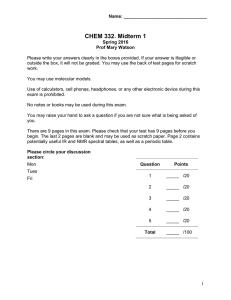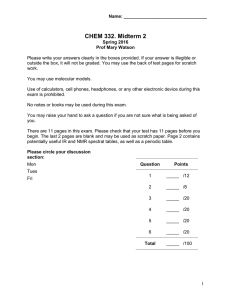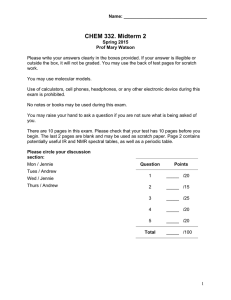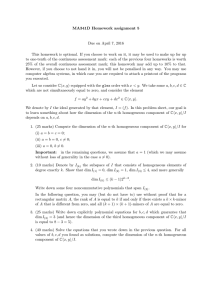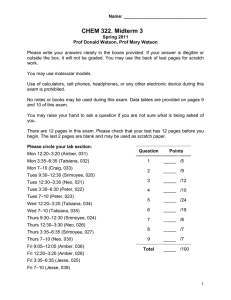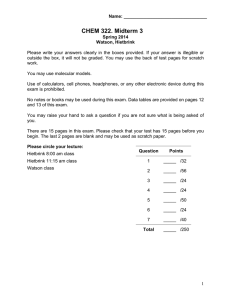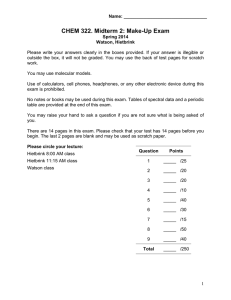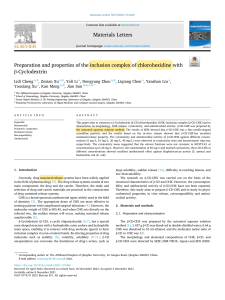CHEM 332. Midterm 1
advertisement
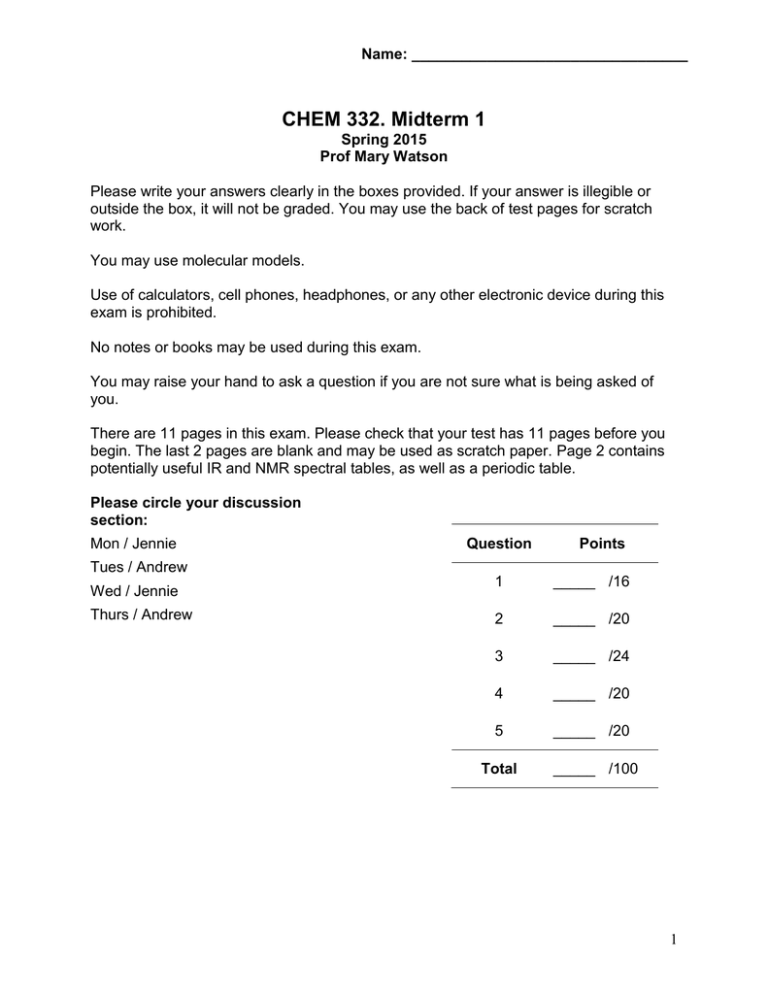
Name: _________________________________ CHEM 332. Midterm 1 Spring 2015 Prof Mary Watson Please write your answers clearly in the boxes provided. If your answer is illegible or outside the box, it will not be graded. You may use the back of test pages for scratch work. You may use molecular models. Use of calculators, cell phones, headphones, or any other electronic device during this exam is prohibited. No notes or books may be used during this exam. You may raise your hand to ask a question if you are not sure what is being asked of you. There are 11 pages in this exam. Please check that your test has 11 pages before you begin. The last 2 pages are blank and may be used as scratch paper. Page 2 contains potentially useful IR and NMR spectral tables, as well as a periodic table. Please circle your discussion section: Mon / Jennie Question Points Tues / Andrew Wed / Jennie Thurs / Andrew 1 _____ /16 2 _____ /20 3 _____ /24 4 _____ /20 5 _____ /20 Total _____ /100 1 Name: _________________________________ Approximate IR Absorption Frequencies Bond O–H (alcohol) O–H (carboxylic acid) N–H C–H CN CC C=O C–O 1 Approximate H NMR Chemical Shifts Hydrogen (ppm) CH3 0.8–1.0 CH2 1.2–1.5 CH 1.4–1.7 C=C–CHx 1.7–2.3 O=C–CHx 2.0–2.7 Ph–CHx 2.3–3.0 2.5 C–H R2N–CHx 2.0–2.7 I–CHx 3.2 Br–CHx 3.4 Cl–CHx 3.5 F–CHx 4.4 O–CHx 3.2–3.8 C=CH 4.5–7.5 Ar–H 6.8–8.5 O=CH 9.0–10.0 ROH 1.0–5.5 ArOH 4.0–12.0 RNHx 0.5–5.0 CONHx 5.0–10.0 RCOOH 10–13 –1 Frequency (cm ) 3650–3200 3300–2500 3500–3300 3300–2700 2260–2220 2260–2100 1780–1650 1250–1050 Intensity Strong, broad Strong, very broad Medium, broad Medium Medium Medium to weak Strong Strong 13 Approximate C NMR Chemical Shifts Carbon (ppm) Alkanes Methyl 0–30 Methylene 15–55 Methine 25–55 Quaternary 30–40 Alkenes C=C 80–145 Alkynes 70–90 CC Aromatics 110–170 Benzene 128.7 Alcohols, Ethers C–O 50–90 Amines C–N 40–60 Halogens C–F 70–80 C–Cl 25–50 C–Br 10–40 C–I –20–10 Carbonyls, C=O R2C=O 190–220 RXC=O (X = O or N) 150–180 2 Name: _________________________________ 1. (16 points) (a) Predict the order of reactivity of the following molecules with ethylene. Number the molecules 1–4, giving 1 to the fastest and 4 to the slowest reaction. (b) Explain your prediction in part A. Remember: A picture is worth 1000 words! 3 Name: _________________________________ 2. (20 points) Please draw the major product for each of the following reactions. The 1H and 13C NMR spectra of compounds B and C are on the next pages. Note: The chemical shifts for peaks are noted at the top of each spectra; these may be helpful in determining coupling patterns. 4 Name: _________________________________ 5 Name: _________________________________ 6 Name: _________________________________ 3. (24 points) Provide the missing reagents for the following transformations. In some cases, more than one step may be required. 7 Name: _________________________________ 4. (20 points) Please draw a reasonable arrow-pushing mechanism for the following reaction. 8 Name: _________________________________ 5. (20 points) Provide a synthesis of 1 from benzene. You may use any inorganic reagents and any organic reagents with no more than 2 carbons. 9 Name: _________________________________ This page was intentionally left blank and may be used for scratch paper. 10 Name: _________________________________ This page was intentionally left blank and may be used for scratch paper. 11
